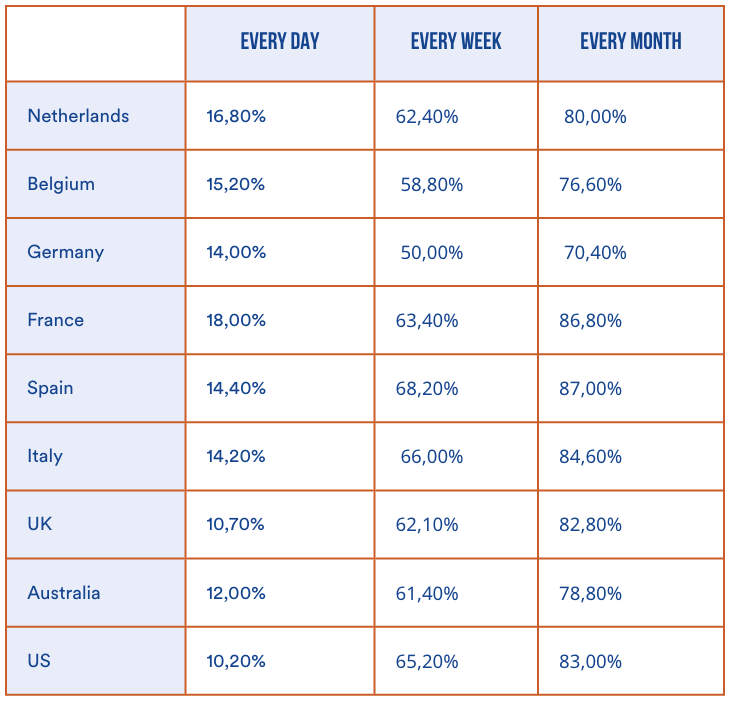In our fast-paced and interconnected world, understanding consumer needs and behaviors is a fundamental element of effective communication and business strategy. To shed light on this critical aspect, Spryng and Commify embarked on an extensive survey, asking thousands of consumers worldwide to discuss their preferred methods of engaging with businesses in the year 2023. Let’s start with the basics of it all; contact frequency. How often do consumers contact businesses in 2023?
Two-way communication between businesses and customers: Is it relevant?
Our findings reflect the fact that most consumers prefer businesses to be as accessible as the most straightforward conversations with friends and family.
When it comes to addressing concerns, consumers demand fast and well-informed responses from organizations. The report compares consumer needs in European nations like Belgium, Germany, France, The Netherlands, and the UK, but also contrasts them with trends in the United States and Australia, as seen on the graph below.

Our research underlines the frequency with which consumers engage with companies. Astonishingly, nearly 2 in 10 individuals communicate with businesses daily. Over 75% of consumers reach out to companies at least once a month, with almost 60% doing so weekly, and 15% engaging with businesses on a daily basis. This highlights the importance of two-way communication between businesses and consumers on both a global scale and for specific countries.
Are you interested in learning more about communication needs and trends? The full research report will be downloadable for free soon.
Consumer Engagement Across Borders: A Global Perspective
In the dynamic landscape of consumer-business interactions, Spanish consumers are leading the pack in active engagement. According to research conducted by Spryng, an astonishing 68.2% of Spanish consumers reach out to businesses on a weekly basis, followed by Italy and the United States, with 66% and 65.2% engagement rates, respectively. These statistics, however, may not be solely attributed to cultural factors.

As we dive further into Europe, the frequency of consumer-business contact shows a steady decline. This could be due to varying cultural norms and preferences across the continent. While Spain, Italy, and the US all prefer frequent interactions with businesses, other European nations exhibit different behaviors and patterns when it comes to the frequency of communicating with businesses.
An astonishing 81.1% of consumers across all surveyed countries contact businesses for several different reasons, including inquiries, questions, and complaints. This reflects the fact that there is a growing expectation of consumers who expect more from the businesses they are in contact with.

This global research emphasizes the importance for businesses to adapt to the ever-changing consumer landscape. Despite the dissimilarity in the frequency of engagement, consumers worldwide are constantly seeking ways to communicate with businesses. To thrive in this competitive environment, businesses must have responsive customer service as a priority and ensure that they are ready to meet the diverse demands of consumers across the globe.
Balancing Consumer Interaction for Business Success
Limited consumer-to-business interaction can appear advantageous from a financial perspective on the surface, but it may be a more complex issue that comes with inherent risks. While minimizing customer contact may seem more efficient, it leaves little to no room for error. When communication frequency is low, and employees fail to assist a customer effectively, that interaction becomes the customer’s primary reference point with your organization. (Williams & Naumann, 2011) For the customer experience to be pleasant and successful one interaction must be positive, otherwise the reputation of the company may be damaged easily.
On the other hand, overly frequent interaction with the customers might implement other challenges and affect the efficiency of a business negatively, since it requires extra resources and a carefully constructed communication system. It is crucial to find a delicate balance between providing meaningful customer care while still maintaining a significant return on investment.
In conclusion, it is highly important to find the balance between providing enough information that the customers are sufficiently aided to get the best possible experience with the company, but not too much information that would overwhelm them. Therefore, effective communication strategies and customer engagement models are essential for achieving long-term success. (Kim et al., 2012).
To sum up, our research emphasizes the importance of consumer-to-business communication. As businesses delegate the complexities of the cultural factors, it becomes clear that there’s no one-size-fits-all approach to customer engagement.
The findings conclude that the consumers’ demands are increasing when it comes to reaching out to businesses, not only on an occasional but oftentimes weekly. This proves that consumers worldwide have increased expectations and seek meaningful interactions with businesses.
However, the most challenging aspect is aiming for the right balance for the amount of information disclosed. Thus, our article advocates for a delicate equilibrium, empathizing being responsive while customizing the engagement for the specific needs of the customer, to ensure sustained success.
At Spryng, we advocate for embracing diversity in communication channels, such as two way communication on platforms that are accessible to every customer. Also depending on the contact frequency, recognizing that there’s no universal approach is crucial. To make the right choice, we encourage consideration of your business objectives, consumer desires, and the distinct advantages each channel offers.
Are you interested in learning more about communication needs and trends? The full research report will be downloadable for free soon.
In this article we aim to present insight into consumer-to-business communication habits as well as to present data from research that has been conducted by Spryng and Commify. The information presented about customer satisfaction is supported by academic research articles such as Customer satisfaction and business performance: a firm‐level analysis (Williams & Naumann, 2011) and Frequency of CRM implementation activities: a customer‐centric view (Kim et al., 2012).
Sources:
Williams, P., & Naumann, E. (2011). Customer satisfaction and business performance: a firm‐level analysis. Journal of Services Marketing, 25(1), 20–32. https://doi.org/10.1108/08876041111107032
Kim, M., Park, J. E., Dubinsky, A. J., & Chaiy, S. (2012). Frequency of CRM implementation activities: a customer‐centric view. Journal of Services Marketing, 26(2), 83–93. https://doi.org/10.1108/08876041211215248








